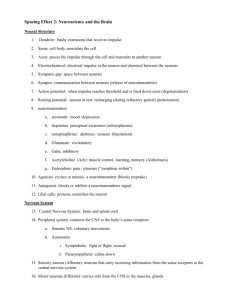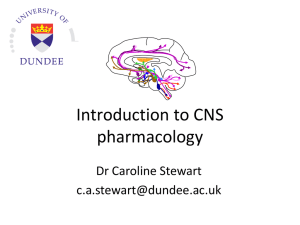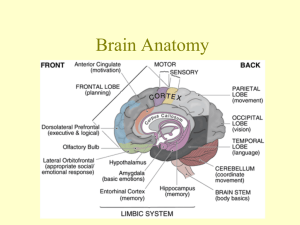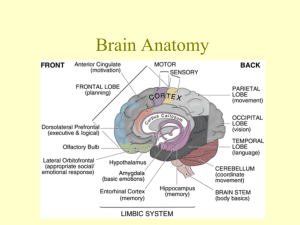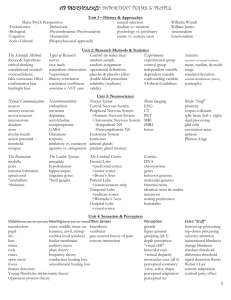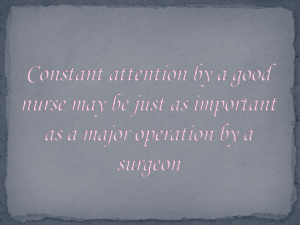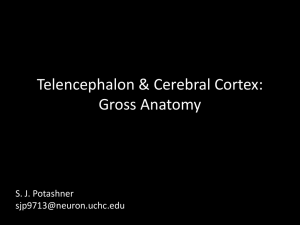CNS
advertisement
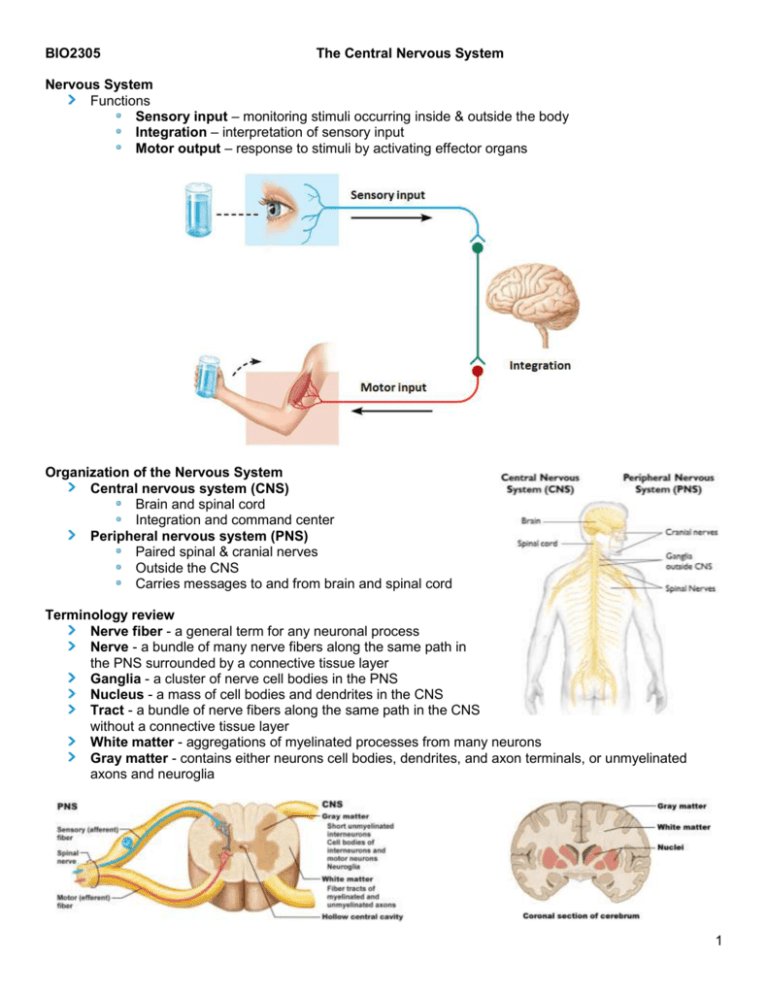
BIO2305 The Central Nervous System Nervous System Functions Sensory input – monitoring stimuli occurring inside & outside the body Integration – interpretation of sensory input Motor output – response to stimuli by activating effector organs Organization of the Nervous System Central nervous system (CNS) Brain and spinal cord Integration and command center Peripheral nervous system (PNS) Paired spinal & cranial nerves Outside the CNS Carries messages to and from brain and spinal cord Terminology review Nerve fiber - a general term for any neuronal process Nerve - a bundle of many nerve fibers along the same path in the PNS surrounded by a connective tissue layer Ganglia - a cluster of nerve cell bodies in the PNS Nucleus - a mass of cell bodies and dendrites in the CNS Tract - a bundle of nerve fibers along the same path in the CNS without a connective tissue layer White matter - aggregations of myelinated processes from many neurons Gray matter - contains either neurons cell bodies, dendrites, and axon terminals, or unmyelinated axons and neuroglia 1 Organization of the Nervous System PNS: Afferent & Efferent Divisions Afferent (sensory) division – transmits impulses from receptors to the CNS. Somatic afferent fibers – carry sensory impulses from skin, skeletal muscles, and joints Visceral afferent fibers – transmit sensory impulses from visceral organs Motor (efferent) division – transmits impulses from the CNS to effector organs. Two subdivisions: Somatic motor fibers – provides conscious control of skeletal muscles Visceral motor fibers (aka Autonomic Nervous System) – regulates smooth muscle, cardiac muscle, and glands Afferent (Sensory) Somatic Sensory General somatic senses – receptors in skin, skeletal muscle, and joints Touch, Pain, Vibration, Pressure, Temperature, Proprioceptive senses Proprioception detects stretch in muscle, stress in tendons Position and movement of body in space Special somatic senses – receptors in eyes, ears, nose, tongue Hearings, Balance, Vision, Smell, Taste Visceral Sensory General visceral senses – receptors in digestive, urinary, and reproductive organs Stretch, Pain, Temperature, Nausea, Hunger 2 Efferent (Motor) Somatic Motor General somatic motor Contraction of skeletal muscles Under voluntary control Often called “voluntary nervous system” Visceral Motor (Autonomic Nervous System) General visceral motor Regulates the contraction of smooth and cardiac muscle and glands Controls function of visceral organs Often called the “involuntary nervous system” Sympathetic Division – “Fight or Flight” Parasympathetic Division – “Rest and Digest” Central Nervous System: Brain Spinal cord Neuron Classification Functional: Sensory (afferent) — transmit impulses toward the CNS Motor (efferent) — carry impulses away from the CNS Interneurons (association neurons) — shuttle signals through CNS pathways; Responsible for integrating afferent information and formulating an efferent response to include higher cognitive functions CNS Support Neuroglia (glial cells) Non-excitable support cells of the CNS Cerebrospinal fluid (CSF) A salty solution that is continuously secreted into and circulating throughout the ventricles and cavities of the brain and spinal cord Blood brain barrier (BBB) Tight junctions in the brain capillaries that prevent free exchange of many small and lipidsoluble substances between the blood and the CSF Neuroglia (glial cells) 3 Neuroglia Neuroglia Neuroglia – specialized nervous tissue cells that are smaller and more numerous than neurons. They serve to carry out support functions such as vascularization, phagocytosis, and myelination. There are four types found in the CNS: Astrocytes – star shaped with many processes, participate in the metabolism of neurotransmitters, maintain proper K+ balance, help form blood brain barrier, and provide a link between neurons and blood vessels Oligodendrocytes – fewer processes and are smaller that astrocytes, most common type in the CNS, they are involved in myelination Microglia – small cells derived from monocytes that function as macrophages and carry out phagocytosis Ependymal – columnar to squamous epithelial cells often ciliated that form a lining in the ventricles (fluid filled cavities in the brain) CNS Protection Hair, skin, cranium, vertebral column Meninges (dura mater, arachnoid mater, pia mater) Cerebrospinal fluid (CSF) Blood brain barrier Meninges 4 Cerebrospinal Fluid (CSF) Shock-absorbing medium Provides an optimum and stable environment for generating APs Provides a medium for the exchange of nutrients and wastes between blood and nervous tissue Formed by selective transport across ependymal cells Volume 125-150 mL and is replaced > 3 times/day, flow maintained by 10 mmHg pressure gradient Choroid plexus Choroid plexus – a network of blood capillaries in the walls of the ventricle The capillaries are covered by ependymal cells that produces the CSF 5 Blood Brain Barrier Blood Brain Barrier – a functional barrier between the interstitial fluid and the blood Structure: Tight junctions promoted by astrocytes whose foot processes envelop brain capillaries & sinuses Function: Limits permeability for most molecules Except: gases and small, lipid-soluble molecules: O2, CO2, alcohol, steroids, H2O Protects brain: hormones & circulating chemicals Protects CNS from chemical fluctuations Prevents entry of harmful substances Prevents entry of molecules that could act as neurotransmitters Cerebral Circulation Cerebral circulation – the movement of blood through the network of blood vessels supplying the brain Brain receives 15% of blood pumped by heart Brain responsible for about half of body’s glucose consumption Membrane transporters move glucose from plasma into the brain interstitial fluid Membrane Transport Restrictions Materials that diffuse through the lipid bilayer cannot be restricted: O2 CO2, alcohol, steroids, H2O Materials that require carrier proteins for transport are restricted: glucose, amino acids and ions Some materials cannot pass the barrier: potentially harmful substances, some hormones/drugs Some areas of the brain do not have a blood-brain barrier (part of hypothalamus) because of their role in monitoring blood homeostasis 6 Brain Organization Trillions of interneurons fill the brain Up to 200,000 synapses each Levels of complexity Cerebral cortex Basal nuclei Thalamus Hypothalamus Cerebellum Brain stem Cerebrum Cerebrum Highly developed Makes up about 80% of total brain weight (largest portion of brain) Inner core houses basal nuclei Outer surface is highly convoluted cerebral cortex Highest, most complex integrating area of the brain Plays key role in most sophisticated neural functions 7 Cerebral Cortex Three specializations: Sensory areas - sensory input translated into perception Motor areas - direct skeletal muscle movement Association areas - integrate information from sensory and motor areas, can direct voluntary behaviors Cerebral Cortex Each half of cortex divided into four major lobes: Occipital lobe – carries out initial processing of visual input Temporal lobe – initial reception of sound sensation, taste, smell Parietal lobe – somatosensory processing Frontal lobe responsible for Motor processing Voluntary motor activity Speaking ability Elaboration of thought Homunculus Homunculus - Latin for "little human“ – proportioned to highlight the amount of cortical tissue of cerebrum dedicated to sensory and motor signals that correspond with different parts of the body Used in various fields of study to reflect the relative space that human body parts occupy on the somatosensory cortex (sensory homunculus) and the motor cortex (motor homunculus) Sensory and motor areas for the hands and face are especially large 8 Primary Somatosensory Cortex Located in the postcentral gyrus on parietal lobe Receives information from the skin and skeletal muscles Exhibits spatial discrimination Somatosensory tracts: from soma (body) cortex Somatosensory homunculus – caricature of relative amounts of cortical tissue devoted to each sensory function Primary Motor Cortex Located in the precentral gyrus on the posterior portion of the frontal lobe Composed of pyramidal cells whose axons make up the corticospinal tracts Corticospinal tracts : from cortex spinal cord Allows conscious control of precise, skilled, voluntary movements Motor homunculus – caricature of relative amounts of cortical tissue devoted to each motor function 9 Language Wernicke’s area Concerned with language comprehension Responsible for formulating coherent patterns of speech Broca’s area governs speaking ability Functional Areas of the Cortex Primary visual cortex – medial surface of occipital lobe receives input from the thalamus (lateral geniculate nuclei) concerning shape, color, and movement Primary auditory cortex – in superior part of the temporal lobe, interprets characteristics of sound, hearing Primary gustatory area – at base of post central gyrus in the parietal lobe receives impulses for taste Primary olfactory area – medial aspect of temporal lobe - receives impulses for smell Supplemental motor area – preparatory role in programming complex sequences of movement Premotor cortex – orients the body and arms toward a specific target, deals with learned motor activities of a complex and sequential nature. Association areas – tracts that connect motor and sensory areas and large parts of the cortex Prefrontal association cortex – planning voluntary activity, decision making, creativity, personality traits Parietal-temporal-occipital association cortex – pools and integrates somatic, auditory, visual sensations for complex perceptual processing, also involved with language Limbic association cortex – motivation and emotion involved with memory 10 Brain Function: Cerebral Lateralization Each lobe has special functions Cerebral Cortex Integration of cortical regions – schematic linking of various regions of the cortex 11 Basal Nuclei Involved in the control of movement Act by modifying ongoing activity in motor pathways Primary functions: Regulates muscle tone throughout the body Selecting and maintaining purposeful motor activity while suppressing useless or unwanted patterns of movement Helping monitor and coordinate slow, sustained contractions, especially those related to posture and support Controls large automatic movement Diencephalon: Thalamus, Hypothalamus, Pituitary 12 Thalamus Final relay point for ascending sensory information All sensory information relays through thalamus except olfaction Coordinates the activities of the cerebral cortex and basal nuclei Domain-specific information processing Directs attention to stimulus of interest: Medial geniculate nuclei – hearing Lateral geniculate nuclei – vision Ventral posterior nuclei – taste and somatic sensations (pain, pressure) Anterior nucleus – emotions and memory Hypothalamus Receives indirect inputs from all sensory systems Controls sympathetic and parasympathetic nervous systems Sends both neural and hormonal outputs to pituitary Coordinates activities of the endocrine and nervous systems Induces emotions and behavioral drives Coordinates voluntary and autonomic functions Regulates body temperature Coordinates circadian cycles 4Fs: feeding, fighting, fleeing, and reproductive behavior 13 Limbic System Cingulated gyrus (Cingulum = “belt” in Latin) Coordinates sensory input with emotions Emotional responses to pain Basic, inborn behavioral patterns related to survival and perpetuation of the species Regulates aggressive behavior Amygdala Involved in emotional responses, hormonal secretions, and memory Hippocampus Consolidation of short-term memory to long-term memory Sends memories out to the appropriate part of the cerebral hemisphere for long-term storage and retrieving them when necessary Plays important role in motivation and learning 14 Cerebellum Basic functions: coordination, balance, motor learning, etc. Vestibulocerebellum – balance and control of eye movement Spinocerebellum – enhances muscle tone and coordinates skilled voluntary movement – important in synchronization and timing Receives input concerning desired action from motor cortex Receives feedback concerning actual action from proprioceptors, vestibular apparatus, eyes Compares inputs and sends adjustments or corrective signals to motor tracts Planning and initiation of voluntary activity by providing input to the cortical motor areas also involved in procedural memories Located posterior to medulla and pons Brain Stem: Midbrain, Pons & Medulla Brain stem – link between spinal cord and higher brain levels Brain stem is composed of: Midbrain Pons Medulla Oblongata Cranial Nerves: 11 of 12 originate from brainstem Olfactory nerve (CN I) originates from forebrain Reticular Formation throughout core of brainstem 15 Cranial Nerves Midbrain Controls eye movement Relays signals for auditory and visual reflexes Contains substantia nigra made of dopaminergic neurons responsible for eye movement, reward seeking, and addiction 16 Pons Contains nuclei that help control respiration Nuclei and tracts link the cerebellum with the cerebrum, brain stem, and spinal cord Sensory and motor nuclei for four cranial nerves Contains ascending, descending, and transverse tracts 17 Medulla oblongata Contains relay stations and reflex centers Cardiovascular and respiratory rhythmicity centers Cardiovascular center – regulates rate and force of heartbeat and vasoconstriction/dilation Respiratory center – regulates basic breathing rhythm Medullary Pyramids – 90% of nerve tracts crossover at pyramids Reticular formation begins in the medulla oblongata and extends superiorly into the pons and midbrain of the brainstem Medulla oblongata 18 Reticular Activating System (RAS) Reticulating (branching) network of neurons in brain stem (reticular formation) Arousal, sleep, pain, & muscle tone Arouses and activates cerebral cortex Blocking ascending pathways between RAS and cerebral cortex creates state of unconsciousness Controls overall degree of cortical alertness or level of consciousness: maximum alertness wakefulness sleep coma ElectroEncephaloGram – EEG Records electrical activity within cerebral cortex from EPSP, IPSPs Used for Diagnose cerebral dysfunction Brain death Sleep Patterns 19 Consciousness – Sleep Functions of Sleep “Catch up” time – restore biochemical and physiological processes Role of adenosine Increased levels while awake Inactivates RAS Caffeine blocks adenosine receptors Shift gears: long term structural and chemical changes required to consolidate memory and learning Learning and Memory Learning has two broad types Associative – conditioning, linking two events together Non-associative Habituation Sensitization Memory has several types Short-term and long-term Reflexive and declarative Memory The storage of acquired knowledge for later recall Memory trace – neural change responsible for retention or storage of knowledge Short-term memory – lasts for seconds to hours Long-term memory – retained for days to years Consolidation – process of transferring and fixing short-term memory traces into long-term memory stores Working memory – temporarily holds and interrelates various pieces of information relevant to a current mental task 20 Long-Term vs Short-Term Memory Short Term Memory Seconds to hours Limited capacity Rapid retrieval Synaptic alterations Changes in ion channels Presynaptic facilitation cAMP Long term potentiation (LTP) Basic Learning - Behavior Habituation – decreased responsiveness to a repetitive stimulus 1. Closure of Ca2+ channels 2. Reduced neurotransmitter release 3. Decrease EPSP 4. Fewer postsynaptic APs generated Sensitization – increase responsiveness to a noxious or intense stimulus 1. Release of serotonin from interneuron 2. Increases cAMP in presynaptic neuron 3. Blocks K+ channels and prolongs AP 4. Ca2+ channels are open longer 5. Increasing neurotransmitter output 21 Long Term Potentiation (LTP) LTP - Activity at a synapse brings about sustained changes in the quality or quantity of synaptic connections Glutamate (NT) from presynaptic neuron binds to both AMPA and NMDA receptors AMPA receptor: Glutamate opens a Na+ channel, and a Na+ influx depolarizes the cell NMDA receptor: Glutamate opens the Ca2+ channel gate Depolarization by AMPA receptor causes ejection of Mg2+ ion from NMDA channel Once NMDA channel is opened (by opening of Ca2+ gate and ejection of Mg2+), Ca2+ enters the cell, and acts in 2nd messenger pathways 2nd messenger pathways cause the postsynaptic cell to become more sensitive to glutamate (upregulating AMPA and NMDA receptors, increase in dendrites and overall surface area of postsynaptic neuron) Retrograde Signaling: Postsynaptic cell also releases an unknown paracrine (once thought to be nitric oxide, but scientists are now unsure) that acts on the presynaptic cell to enhance glutamate release 22 Long Term Memory Last days to years Unlimited capacity Permanent structural changes Formation of new synapses between existing neurons Increased dendritic surface area Increase in neurotransmitter receptors Changes in neurotransmitter synthesis Long Term Memory Consolidation is affected by: Amount of rehearsal Association of new & old data Level of excitement/importance of information CREB – regulatory proteins that activate genes important in long term memory storage Memory Processing Hippocampus (limbic system) Short term memory and consolidation Declarative memory (facts), specific objects Requires conscious recall Cerebellum – “how to” memories Motor skills (procedural) Subconscious recall Prefrontal cortex – working memory Processes new and retrieved information Temporary storage Problem solving, planning, organizing 23 Spinal Cord Regions Cervical Thoracic Lumbar Sacral Spinal Cord Organization Gray matter: mostly cell bodies Dendrites & terminals Spinal reflex integrating center White matter Bundles of myelinated axons Ascending tracts (sensory) – send action potentials superiorly to brain Descending tracts (motor) – bring action potentials inferiorly from brain to body Dorsal roots – allow action potentials to enter the spinal cord, providing sensory information from the peripheral tissues Ventral roots – allow action potentials to exit the spinal cord and reach peripheral tissues 24 Spinal Cord Organization Spinal Integration and Reflex Pathway 25 Neural Reflexes Stimulus Sensory receptor Sensory (afferent) neuron CNS integration Efferent (motor) neuron Effector (target tissue) Response (movement) Feedback to CNS Reflexes Reflex - a fast, predictable, automatic response to changes in the environment that helps maintain homeostasis. Three types of reflexes: cranial reflexes, somatic reflexes, and visceral (autonomic) reflexes Reflex arc - simplest pathway, involving five components: 1. Receptor – distal end of a sensory neuron (dendrite) that responds to a stimulus 2. Sensory neuron/afferent pathway – conducts impulse from receptor to axon terminal located in the gray matter. 3. Integrating center in CNS – may be monosynaptic or polysynaptic involving other association neurons 4. Motor neuron/efferent pathway – relays impulse from integrating center to part of the body that will respond. 5. Effector – gland or muscle that responds to motor neuron impulse. Monosynaptic and Polysynaptic Reflexes 26 Patellar Tendon Reflex: Stretch & Reciprocal Inhibition Cross Extensor Reflex/Withdrawal Reflex 27

